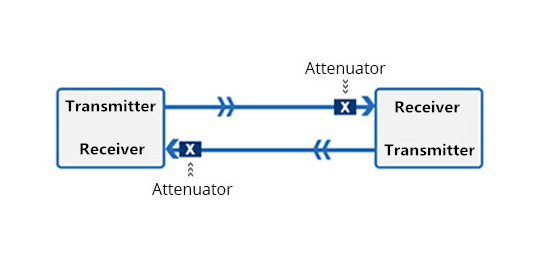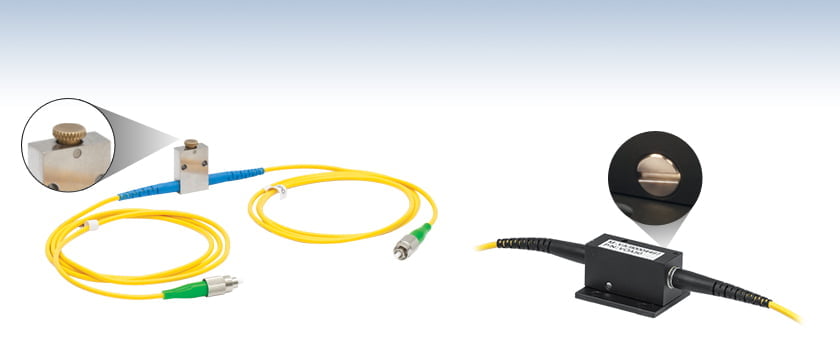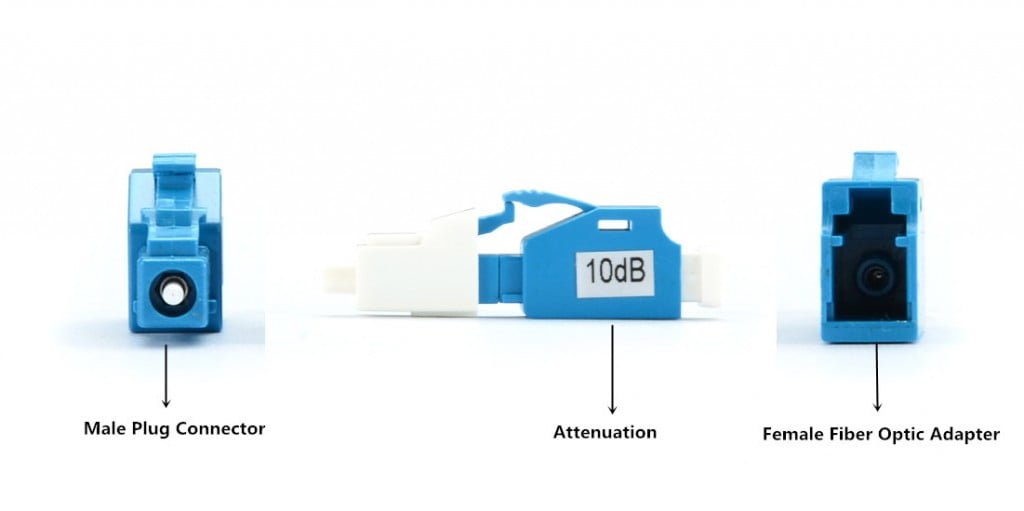Fiber optic Attenuator or An optical attenuator, or fiber optic attenuator, is a device used to reduce the power level of an optical signal, either in free space or in an optical fiber. The basic types of optical attenuators are fixed, step-wise variable, and continuously variable.
Fiber optic attenuators are devices which reduce (attenuate) the strength of a fiber optic signal within a fiber optic network. Attenuators are usually used when the signal arriving at the receiver is too strong and hence may overpower the receiving elements. This may occur because of a mismatch between the transmitters/receivers (transceivers, media converters), or because the media converters are designed for a much longer distance than for which they are being used. Sometimes attenuators are also used for stress testing a network link by incrementally reducing the signal strength (increasing the dB attenuation) until the optical link fails, thus determining the signal’s existing safety margin.

A fiber optic attenuator is a passive device used to reduce the amplitude of a light signal without significantly changing the wave form itself. This is often a requirement in Dense Wave Division Multiplexing (DWDM) and Erbium Doped Fiber Amplifier (EDFA) applications where the receiver cannot accept the signal generated from a high-power light source.
If the power is too high as it often is in short single mode systems with laser transmitters, you can reduce receiver power with an attenuator. The power reduction is done by such means as absorption, reflection, diffusion, scattering, deflection, diffraction, and dispersion, etc. Optical attenuators usually work by absorbing the light, like sunglasses absorb extra light energy. They typically have a working wavelength range in which they absorb all light energy equally. They should not reflect the light or scatter the light in an air gap, since that could cause unwanted back reflection in the fiber system. The attenuating fiber is produced by using a solution doping technique to introduce transition or rare earth elements into the fiber’s core. The dopant reduces the transmission of the fiber. The degree of attenuation depends upon the material used as the dopant, the dopant level, and the length of the attenuation segment.
Optical attenuators can take a number of different forms and are typically classified as fixed or variable attenuators. What’s more, they can be classified as LC, SC, ST, FC, MU, E2000 etc. according to the different types of connectors.
Fixed Attenuators

Fixed optical attenuators used in fiber optic systems may use a variety of principles for their functioning. Preferred attenuators use either doped fibers, or mis-aligned splices, or total power since both of these are reliable and inexpensive. Inline style attenuators are incorporated into patch cables. The alternative build out style attenuator is a small male-female adapter that can be added onto other cables.
Non-preferred attenuators often use gap loss or reflective principles. Such devices can be sensitive to: modal distribution, wavelength, contamination, vibration, temperature, damage due to power bursts, may cause back reflections, may cause signal dispersion etc.

Loopback attenuators
Loopback fiber optic attenuator is designed for testing, engineering and the burn-in stage of boards or other equipment. Available in SC/UPC, SC/APC, LC/UPC, LC/APC, MTRJ, MPO for singlemode application.900 um fiber cable inside of the black shell for LC and SC type. No black shell for MTRJ and MPO type.

Built-in variable attenuators
Built-in variable optical attenuators may be either manually or electrically controlled. A manual device is useful for one-time set up of a system, and is a near-equivalent to a fixed attenuator, and may be referred to as an “adjustable attenuator”. In contrast, an electrically controlled attenuator can provide adaptive power optimization.
Attributes of merit for electrically controlled devices, include speed of response and avoiding degradation of the transmitted signal. Dynamic range is usually quite restricted, and power feedback may mean that long term stability is a relatively minor issue. Speed of response is a particularly major issue in dynamically reconfigurable systems, where a delay of one millionth of a second can result in the loss of large amounts of transmitted data. Typical technologies employed for high speed response include liquid crystal variable attenuator (LCVA), or lithium niobate devices. There is a class of built-in attenuators that is technically indistinguishable from test attenuators, except they are packaged for rack mounting, and have no test display.

Variable optical test attenuators
Variable optical test attenuators generally use a variable neutral density filter. Despite relatively high cost, this arrangement has the advantages of being stable, wavelength insensitive, mode insensitive, and offering a large dynamic range. Other schemes such as LCD, variable air gap etc. have been tried over the years, but with limited success.
They may be either manually or motor controlled. Motor control give regular users a distinct productivity advantage, since commonly used test sequences can be run automatically.
Attenuator instrument calibration is a major issue. The user typically would like an absolute port to port calibration. Also, calibration should usually be at a number of wavelengths and power levels, since the device is not always linear. However a number of instruments do not in fact offer these basic features, presumably in an attempt to reduce cost. The most accurate variable attenuator instruments have thousands of calibration points, resulting in excellent overall accuracy in use.
What Is Fixed Fiber Attenuator?
Fixed fiber optic attenuator, also called fixed plug type or fixed build-out fiber attenuator, is used in fiber optic communications to reduce the optical fiber power by a certain level. Typical attenuation values are between 1 and 30 dB. Usually, it has a male plug connector at one side to allow fiber attenuator to be plugged directly into receiver equipment or adapters in patch panel, and has female type fiber optic adapter at the other side to allow the patch cords to plug in. Fixed fiber optic attenuator name is based on the connector type and the attenuation level. LC attenuator 5dB means this attenuator uses LC fiber optic connector, and it can reduce the optical fiber power level by 5dB.
Fixed Fiber Attenuator
Fixed Fiber Optic Attenuator Types
Fixed fiber optic attenuators are available in LC, SC, ST, FC and MU style with APC and UPC polish. Generally, multimode systems do not need attenuators as the multimode sources, VCSELs, rarely have enough power output to saturate receivers. Instead, single-mode systems, especially short links, often have too much power and need attenuators. Therefore, fixed fiber optic attenuators are usually single-mode types. The most commonly used type is LC single mode female to male and female to female fixed fiber optic attenuator. Unlike the common female to male type mentioned above, the female to female fixed fiber optic attenuators have female type fiber optic adapter at the both ends, which are also therefore called fiber optic adapter type attenuators. They can be used as adapters and attenuators at the same time.
Fixed Fiber Attenuator Types
How to Use Fixed Fiber Attenuator?
As shown in the figure below, fixed fiber optic attenuators should be always installed at the receiver end of the link (X in the drawing). This is because it’s more convenient to test the receiver power before and after attenuation or while adjusting it with your power meter at the receiver, plus any reflectance will be attenuated on its path back to the source.
How to Use Fixed Fiber Attenuator
For female to male fixed fiber optic attenuators, we can plug the patch cord to the female fiber optic adapter of the attenuator. And then plug the male plug connector of the attenuator to the equipment directly. For female to female fixed fiber optic attenuators, we should plug the two patch cords to the two female fiber optic adapter of the attenuator (shown in the figure below).
Female to Male Fixed Fiber Optic Attenuators


Fiber optic Attenuator
Thank you for your sharing. I am worried that I lack creative ideas. It is your article that makes me full of hope. Thank you. But, I have a question, can you help me?